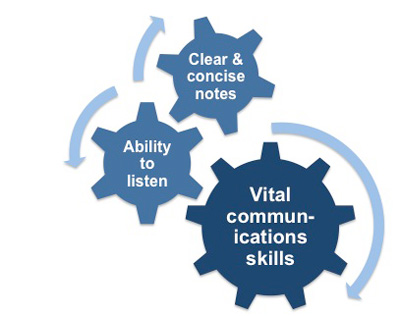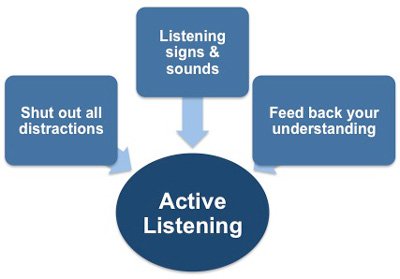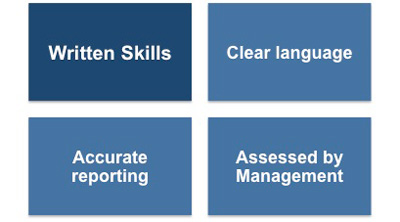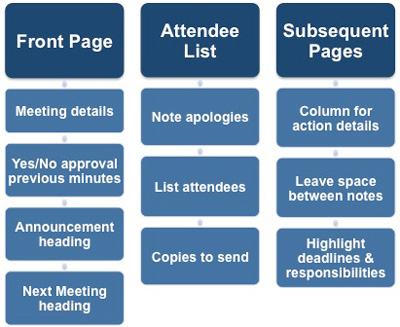How to Take Meeting Minutes
There are two crucial communication skills you require to ensure that your minute taking is an accurate reflection of what took place during a meeting. These are the ability to listen, and the ability to take clear and concise notes.
 |
By proficiently performing both of these skills you will be able to accurately communicate the decisions made at the meeting to everyone involved.
Active Listening
Your ability to really listen to those who are talking to you is a skill you can enhance. Developing your ability in this way will help you to gain greater levels of information and further your understanding of the topic under discussion.
Many research projects have shown that we only retain between 25 and 50 percent of what we hear. If you look at this in terms of your average thirty-minute meeting you will be attentive and listen to less than half of it. You will not hear, or appreciate, the nature of the message the speaker wants to communicate.
This level of listening is not going to enable you to make sufficient notes to produce accurate minutes, as you will not be able to truly understand the speaker's communication. You can overcome this by changing your behavior to that of an active listener.
Your behavior needs to demonstrate three key aspects to the speaker:
1. You are paying attention to the conversation.
2. You are actively showing that you are listening to them.
3. You demonstrate your understanding of their message through feedback.
 |
Show Your Attention
You will achieve this by ensuring that you shut out all distractions, including boredom, from your mind and give 100% of your attention to the speaker's words, tone, and meaning. You must not let yourself think about your response or reaction to the nature of the conversation; this must only be considered once the speaker has finished. This enables you to be more accurate in the notes you make.
By waiting until the end of the message you will have a greater understanding of the communication and therefore your resulting response will be more persuasive.
Demonstrate You Are Listening
You will be able to demonstrate this to your speaker by the position you adopt. During the meeting where possible you need to be facing them and maintain eye contact. You should also nod your head, raise your eyebrow, or smile to indicate that they still have your attention.
Outside of a meeting situation if you are talking to a person you can utter verbal confirmation that you are still listening by saying such things as, 'Um,' 'Uh huh,' 'Yes,' or 'No,' whatever is most appropriate.
Display Your Understanding
The best way to show that you have understood and appreciated what the speaker has said is by feeding this back through the technique of paraphrasing. For example, 'Do you mean …… is the key issue?,' 'Can I clarify that you meant …..?,' 'If I summarize what you've just said as …. is that accurate?'
These are skills you can develop in all your conversations so you will have plenty of opportunity to become an active listener.
Writing Notes
The rough notes provide the backbone of your minutes and need to be a true description of discussions that took place. Your notes need to be clear and informative enough for you to make sense of them when you come to write them up!
 |
Your ability and skill at communicating with the written word will be reflected in the accuracy and clarity of language you use to express what was said during the meeting. Many of your peers and seniors will receive the minutes and judge you on their quality.
There are certain steps you can take to ensure your communication skills are perceived in the best manner. Try following these general guidelines:
- Use a front page to contain the major headings required which will be easy to record. For example;
- Meeting name and title, date, time, and place.
- A 'Yes / No' to circle under the heading of 'Approval of previous minutes.' Leave several lines for outstanding items to be listed and details of critical issues to be written down.
- A heading for 'Announcements'
- A heading for the date, time, and location of the 'Next Meeting.' Ensure you have a diary with you to avoid any confusion over dates and have an awareness of the traveling times involved if the meeting moves to another location.
 |
- Have your list of attendees ready to pass round with non-attendees already marked up.
- In all subsequent pages divide the page so you have a narrow column down the right-hand side for recording who is responsible or accountable for the action. You may want to use a separate column for recording timescales against each action.
- As you take notes always underline or highlight the heading for each separate item.
- Leave a few lines between each item, so you have room to add other points if the discussion comes back to a particular item later in the meeting.
- Underline or highlight decisions on who has agreed to do what and by when.
The most important thing is to write the minutes up in a timely fashion. You should allocate some time either immediately after the meeting or the next day to perform this task. Others are relying on you to send these minutes out and they will act as a reminder for those who have actions that need to be completed before the next meeting. This Meeting Minutes Tasks Checklist covers those tasks you need to complete before, during and after the meeting if you are taking the minutes. This Meeting Minutes Template provides a structured means to record all essential discussion details and findings.
Don't put the job off for weeks - it makes a huge difference if the meeting is still fresh in your mind and others are relying on you to provide them with an accurate communication from the meeting.
You may also be interested in:
Taking Meeting Minutes | Elements of Meeting Minutes | Responsibilities of the Minute Taker | Potential Problems When Taking Minutes | Meeting Minutes Checklist.



